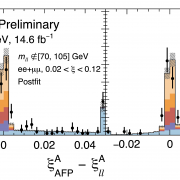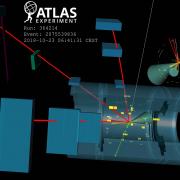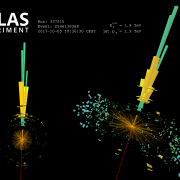Access to Collaboration Site and Physics Results

Until now, the Higgs boson had been observed decaying to photons, tau-leptons, and W and Z bosons. However, these impressive achievements represent only 30% of the Higgs boson decays! The Higgs boson’s favoured decay to a pair of b-quarks (H→bb), which was predicted to happen around 58% of the time and thus drives the short lifetime of the Higgs boson, had so far remained elusive. Observing this decay would fill in one of the big missing pieces of our knowledge of the Higgs sector. It would confirm that the Higgs mechanism is responsible for the masses of quarks and might also provide hints of new physics beyond our current theories. All in all, it is a vital missing piece of the Higgs boson puzzle!
But if it is the dominant Higgs boson decay, and we’ve now created over 1 million H→bb decays in ATLAS alone, then why haven’t we seen it yet? This seems especially strange when you consider that we discovered the Higgs boson in other, far less frequent decays.
The answer lies in the abundance of b-quarks created in the ATLAS detector due to strong interactions. We create pairs of b-quarks 10 million times more frequently than we create a H→bb decay, which makes picking them out against that large background an extremely challenging task. We therefore look for H→bb decays when they are produced in association with another particle, in this case a vector boson (W or Z). The more distinctive decays of vector bosons provide a way to reduce the large background. This leads to a much lower production rate – we expect to have created only 30,000 H→bb decays this way – but it provides an opportunity to spot this elusive decay.
Observing this decay fills in one of the big missing pieces of our knowledge of the Higgs sector.
Nevertheless, even in this condition the background processes that mimic the H→bb signal are still large, complex and difficult to model. A huge effort was spent by ATLAS collaborators to isolate the small H→bb signal from the large background. After selecting the collisions of interest, we were left with an expected number of around 300 H→bb events compared to 70,000 background events. Ultimately, we were hoping to see an excess of collision events over our background prediction (a bump) which appears at the mass of the Higgs boson.
After analysing all the data ATLAS collected in 2015 and 2016, we have finally reached the level of precision where we can say we’ve seen evidence for H→bb, with an observed significance of 3.6 σ when combining the Run 1 and Run 2 datasets. As shown in the figure, a bump is observed that is very consistent with our expectation, confirming many key aspects of the Higgs bosons behaviour. Next to the bump one can see the decay of a Z boson (mass of 91 GeV) to a b-quark pair, produced in a similar way as the Higgs boson, but more abundantly. It serves as a powerful validation of the analysis.
Spotting H→bb is just the beginning! Studies of this new decay will open a whole new window onto the Higgs, and may also provide hints of new physics beyond our current theories. Stay tuned to this channel.
Links:
- Evidence for the H→bb decay with the ATLAS detector (ATLAS-CONF-2017-041).
- EPS 2017 presentation by Song Ming Wang: Measurement of fermionic couplings of the SM Higgs boson using the bb, tautau and mumu decay channels with the ATLAS detector
- See also the full lists of ATLAS Conference Notes and ATLAS Physics Papers.








